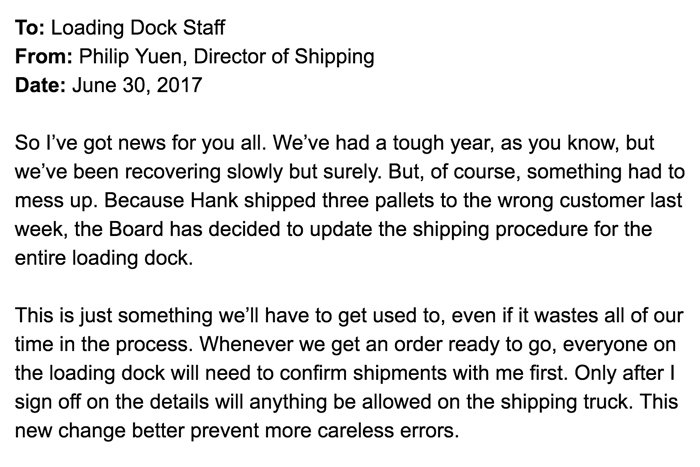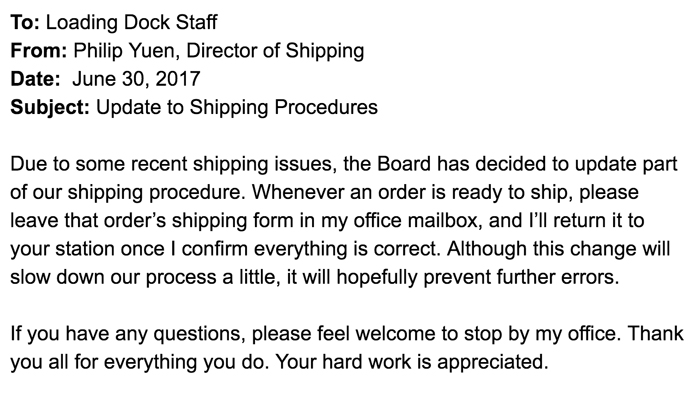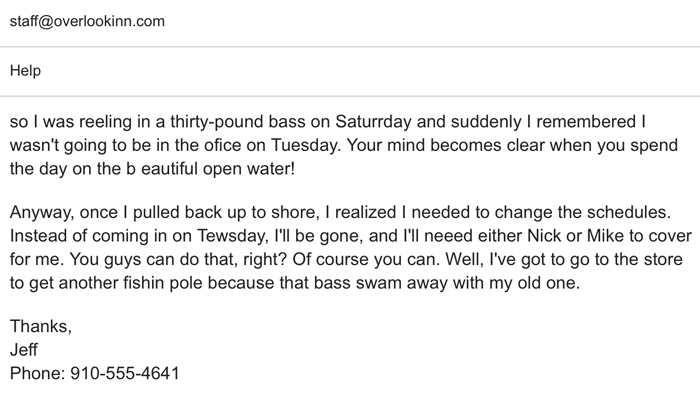How to Write a Professional Email
| Title: How to Write a Professional Email | Author: Shannon Buerosse |
| Subject(s): English Language Arts | |
| Grade Level(s): 8th Grade | Total Time: 40-60 minutes |
Overview / Description:
Students will learn about the qualities of a professional piece of correspondence and will be able to correct unprofessional correspondence to be appropriate for the workplace.
Learning goals/objectives:
After completing this activity, students should be able to . . .
- Identify the heading, body, and closing of an email
- Identify and correct instances of informal speech within an email
- Know when it is appropriate/inappropriate to be informal in communication
Workplace Readiness Skill:
| X | Social Skills | X | Communication |
| Teamwork | Critical Thinking | ||
| Attitude and Initiative | Planning and Organization | ||
| X | Professionalism | Media Etiquette |
Content Standards:
Wisconsin Standards for English Language Arts
Writing
W.8.2 Write informative/explanatory texts to examine a topic and convey ideas, concepts, and information through the selection, organization, and analysis of relevant content. d. Use precise language and domain-specific vocabulary to inform about or explain the topic. e. Establish and maintain a formal style.
W.8.4 Produce writing that is appropriate for the task, purpose, or audience.
Language
L.8.2 Demonstrate command of the conventions of standard English capitalization, punctuation, and spelling when writing. a. Use punctuation (comma, ellipsis, dash) to indicate a pause or break. b. Use an ellipsis to indicate an omission. c. Spell correctly.
Wisconsin Comprehensive School Counseling Model:
D.2 Acquire and demonstrate acceptable interpersonal skills as they relate to understanding oneself and others.
D.8.2.1 Demonstrate effective writing, speaking, listening, and nonverbal communication skills
G.2 Develop positive interpersonal skills necessary to be effective in the world of work
G.8.2.2 Demonstrate effective communication skills, including writing, speaking, listening, and nonverbal behavior
Materials:
Link to poor email example #1, image attached below
Link to poor email example #2, image attached below
Learning Activities:
WHO (T=Teacher Focus Lesson; WG=Whole Group\; SM=Small Group; I=Independent)
| Learning Activity Task | WHO is responsible for this step? | Approximate time for task |
| Teacher will introduce the topic of sending emails/texts. Ask students how they speak to different people. What do your messages look like? Do you abbreviate? Do you use emojis? How is the way you speak different for different people? Talk about how when you are in the workplace, you need to use a more formal tone than when you are talking to family and friends. | Teacher-led discussion | 5-10 minutes |
| Brainstorm with the class different abbreviations and slang used while they normally message: ex. ASAP, OMG, LOL, wanna, y'all. Discuss that these are things to avoid, as well as cliches and sayings, such as 'I'll get that to you in a jiffy.' | Teacher-led discussion | 5-10 minutes |
| Introduce the first example to the class, highlighting what errors/instances of informality are present. Discuss ways it could be fixed or alternate ways that information could have been communicated to make it more formal. Go through the corrected example. | Teacher-led discussion | 10-15 minutes |
| Assign the second example for the students to work through and correct. Depending on student understanding, you can have them work independently or in pairs. | Student | 10-15 minutes |
| Have students write a corrected email independently. | Student | 10-20 minutes |
Assessment:
Students will be rewriting the second email. Assessment is focusing on proper spelling, grammar, and maintaining a formal tone.
Formal Email Assessment Rubric
Wrap-Up:
Go over possible corrections as a class.
Extension Activity (for intervention or enrichment):
Have students write their own professional email. Possibly partner with a local company to pair each student with an industry mentor who will read and respond to their email with feedback on their formatting and professionalism.

Poor example of an email #1

Possible corrections for poor email example #1

Poor example of an email #2

Possible corrections of a poor email example #2